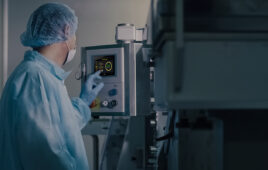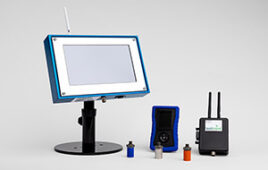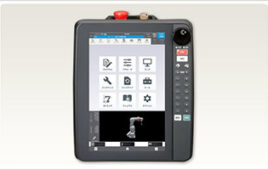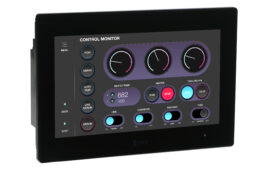Headless human-machine interfaces can be the best choice for integrating large-format and mobile visualization options into industrial automation applications.
By Bill Dehner, technical marketing engineer, AutomationDirect
Designers and end-users of industrial automation applications are working to offer more visualization options than ever, driven in part by a world of consumer electronics with touchscreen displays on almost everything. Traditional all-in-one panel-mount human-machine interface (HMI) displays are still the norm. Many industrial HMI devices have the ability to interact with distributed PC-based options and mobile clients. However, for some cases, it turns out that a “less is more” approach is the best way to provide enhanced HMI options.
Conventional HMIs are built for the industrial environment and are compact enough to be located almost anywhere on a machine or the factory floor. But sometimes end-users need to drive much larger displays visible from a distance. It is also increasingly popular to supplement or replace the classic stationary HMI experience with a purely mobile alternative using smartphones or tablets.
Some end users are finding they need external displays or mobile access for their automated systems, but don’t need the standard local HMI experience. In these cases, an HMI device without a local display can be less expensive and easier to install, while providing the required functions. Here are some tips for and benefits of using headless HMIs to support industrial automation user needs for more effective visualization.
Next step in HMI progress
The earliest generations of graphical HMIs introduced in the 1990s were relatively crude, although still a huge upgrade from traditional panel-mount buttons, lights, and gauges. End users found these digital HMIs enabled them to quickly create useful indications and easily adjust functions.
Over the years, HMIs progressed in many areas, making them ever more useful for industrial applications. The displays became larger and brighter, with more colors and finer resolution. While most displays still require a level of protection, many are designed for use in harsh environments. Keypads transitioned to reliable touchscreens in many designs, increasing ease of use (Figure 1).

Traditional HMI touchscreen installed on a factory floor. Conventional HMI touchscreens, like this AutomationDirect C-more, provide extensive automation monitoring and control functionality on the factory floor.
Beyond basic graphics and touch links, HMIs gained the ability to display animations, handle alarm logs, “historize” data, show trends, communicate using various protocols, and manage events. Ethernet and USB technologies made it simpler to configure and connect HMIs to other automation system components, and to each other.
In recent years, two more consumer electronic trends have affected how HMIs are perceived. One is the wide availability of high resolution, lightweight, large-screen consumer displays. Not only has this LCD technology trickled into industrial HMI devices, but now end users may sometimes prefer to use these types of displays in conjunction with the HMI. The second trend is the proliferation of mobile connectivity and handheld mobile devices, to the extent that many users prefer these smart devices as their HMI of choice.
HMIs go big
Conventional HMI display diagonal sizes typically span from around 6 to 15 inches, which is a practical and usable range. However, there are good reasons for end-users to prefer other sizes and types of displays in their HMI applications.
One case is where field equipment is installed at an environmentally harsh or outdoor location, but there is a protected control room type environment nearby. If it is possible to install the display portion of the HMI in the office environment, there is no need to pay extra for an industrialized HMI. In fact, when possible it is often better to design a system to locate the HMI displays in protected environments, instead of trying to specify a unit subject to UV or chemical degradation in a harsh area.
Even when tough installation conditions are not present, it is becoming more popular to install HMIs in office areas of manufacturing businesses as a convenient always-on way of delivering plant floor data to operations supervisors and even the board room.
An alternate version of this is when end-users need large displays, often using inexpensive 55-in. TVs operating at 720p (1280×720 standard HD). These can be “scoreboards” providing information such as current alarms for plant floor workers in a production area, or sometimes the performance of a machine or equipment operation boiled down to key process indicators (KPIs), providing a quick way for workers to see system status (Figure 2).

When a consumer-type remote display is used the preferred connection type is usually HDMI because it can transmit sufficient resolution along with sound. Users can even connect the HDMI signal through splitters, boosters, and other video management systems to extend the display connections to multiple displays.
HMIs go far
The best HMI display may not be a unit designed for fixed installation on the factory floor, but instead is often a mobile device, such as smartphone or tablet. The use of mobile HMI connectivity is increasing throughout industry, enabled largely by HMIs able to natively support remote access through browsers or dedicated mobile devices. Operators and maintenance personnel often appreciate the flexibility of monitoring and even controlling their systems from a handheld interface (Figure 3).
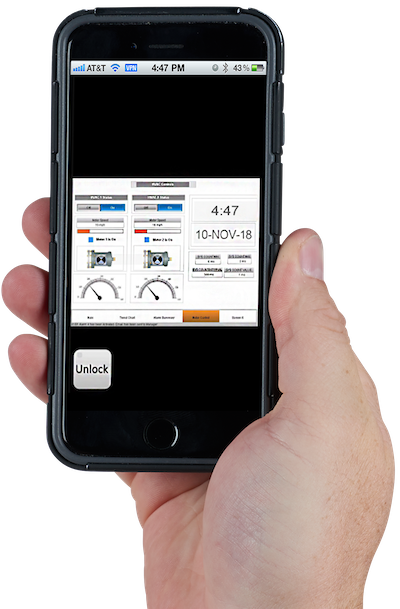
Image of a mobile HMI app displayed on a smartphone. The AutomationDirect C-more HMI units, whether they have a display or are headless, support remote and mobile display connections.
Therefore, there is often less of a reason to have a local HMI display. Or, designers can include one local HMI display for use if needed, but otherwise design their systems with one or more headless HMIs designated to support remote locations.
Depending on the control system network architecture, a headless HMI can be located almost anywhere. Many times this would be right at a machine and protected within a control panel, but it could also be any other convenient factory floor location or computer server room.
Headless HMI benefits
For the preceding remote display and remote access cases, headless HMIs are often the preferred solution (Figure 4). The HMI unit itself is optimized for installation within a control panel almost anywhere. It should maintain all common HMI functionality, but just without the display portion. Headless HMIs still need Ethernet, USB, serial, and SD card abilities.

AD EA9-RHMI headless HMI. Headless HMIs, like this AutomationDirect device, are easier to install, save money, and can support external displays and mobile HMIs.
As compared to traditional HMIs, there are many additional benefits of using headless HMIs, beyond letting designers select their own displays or enabling operators to use mobile devices:
• Lower cost since the display is not on-board
• Compact footprint within a control panel
• No control panel cutouts needed, preserving the enclosure NEMA rating
• Less power consumption and heat generation
• Users can change the display size/type in the future economically
• Supports external monitors with touchscreens or other input devices
• HDMI can transmit sound via the display sound system
• One mobile HMI can access many headless devices, providing a common interface
• Easily and inexpensively add advanced features including data logging and email capability
Of course, headless HMIs will typically cost less than versions with built-in displays. Looking past the hardware cost, the most fundamental technical feature of headless HMIs is their small size and minimal footprint within a control panel. Because no control panel cutouts are needed, installation effort is reduced, and there are no issues with impacting the enclosure NEMA rating. Reduced power requirements and heat generation make them easier to include in a design.
Physical displays used with headless HMIs can be industrial types, but in many cases consumer-grade displays are fine. Since they are located on desktops or wall mounts, it is easy and economical to replace these displays in the future or even change the size. Most types of external touchscreen displays, or other input devices like common keyboards and mice, can be easily integrated with headless HMIs using USB connections.
HDMI connections transmit video and sound in one connection, so designers can create HMI configurations that broadcast alarm and event notification sounds to call operator attention to the display. Installing the HDMI cable can require some effort, and there are distance limitations for HDMI and for USB connections. However, many end-users will find it convenient to locate the headless HMI a short distance from the display, so long as a network connection and power are available.
For mobile HMI applications, a good plan is to install enough headless HMIs to provide dedicated support for however many concurrent remote sessions are expected. Or, several identical machines may each have their own dedicated HMIs. Operators could then use a single mobile device to access any of the individual machine HMI devices as needed.
A final point is that a headless HMI can be used to add other advanced functions not necessarily requiring an HMI display. The best examples are data logging to an SD card, or generating notification alarms and emails. These features may be included with a new automated machine or retrofitted into any existing system.
Comprehensive HMI capabilities have become not just commonplace but necessary for any industrial automation system. Headless HMI devices are a relatively recent development, giving designers more options. They can locate headless HMIs almost anywhere, use any size external display, enable mobile HMI connectivity, or even choose to implement advanced HMI features without incurring the expense of a display. The reduced cost and added flexibility mean that for headless HMIs, less really can be more.
AutomationDirect
www.automationdirect.com
Bill Dehner has spent the majority of his fourteen-year engineering career designing and installing industrial control systems for the Oil and Gas, Power, and Package Handling industries. He holds a bachelor’s degree in Electrical Engineering with an associate’s in Avionics from the USAF and is currently working for AutomationDirect as a technical marketing engineer.
Filed Under: Displays • HMIs • operator interfaces • monitors

